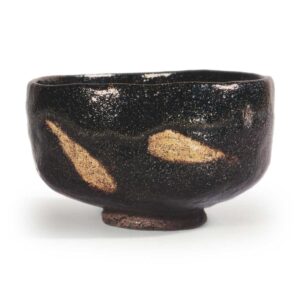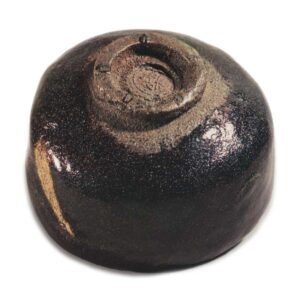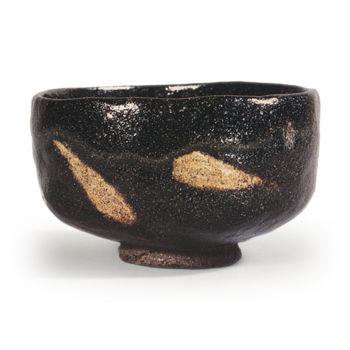

Collection: Fujita Art Museum
Height: 7.8cm
Diameter: 12.2-12.5cm
Base diameter: 5.3-5.5cm
Height: 0.8-1.0cm
The name “Chidori” was given by Hachisō in reference to the shape of the rim, which is triangular, and the similarity to the chidori (plover) in Korin’s paintings.
The rim is slightly turned inwards, and the clay is a whitish sesame clay. The foot is sharply made, and the strong inner grooves show the distinctive sharpness of Nōkō ware.
There are five trays on the tatami mat, and inside the foot ring, the Nong Ko “raku” seal is strongly pressed, causing the piece to warp slightly, and the seal is extremely clear, giving a refreshing feeling.
The whole piece is covered in a black glaze with a candy-like sheen, and the inside and outside are covered in a beautiful, glossy maku-yaki glaze, which is Nonkou’s specialty, and it is magnificent. There are two yellow spots on the outside, which look like reeds, and they create a scene reminiscent of a plover. There are also some scuff marks near the rim.
In old Japanese-English dictionaries, the term “nonkou” is used to describe a type of bowl with a wide, flat bottom and a wide, shallow “tea pool” at the bottom, and this bowl is a good example of this type of bowl, with a wide, shallow “tea pool” that extends across the entire bottom.
In other words, the characteristics of Nongou are fully demonstrated in the way it was made and glazed, and in addition to this, it is listed as one of the seven types of Nongou as a rare and excellent piece with a clay seal.
Accessories:
Bag, white habutae
Inner box: paulownia wood, white lacquer, inscription on the underside of the lid by Hara Sō: “Nonkō ware, black tea bowl, named Chidori, left (signature)” and seal “Rokō Shin-shō”
Outer box: paulownia wood, white lacquer, inscription on the front of the lid by Hirase Rokō: “Chidori Michi-iri-saku”
Seal on the reverse of the lid: Rokō Kansō-in
This tea bowl was passed down in the Heise family of the Chigusa-ya tea shop in Osaka, and when the family sold off their collection in 1903, Kosetsu Fujita purchased it for 16,000 yen, causing a sensation in the world of tea. After the Meiji Restoration, the Chidori tea bowl was the first tea bowl to sell for over 10,000 yen, and it is clear that it had an outstanding reputation as a tea utensil from ancient times. It is currently in the collection of the Fujita Museum of Art.



